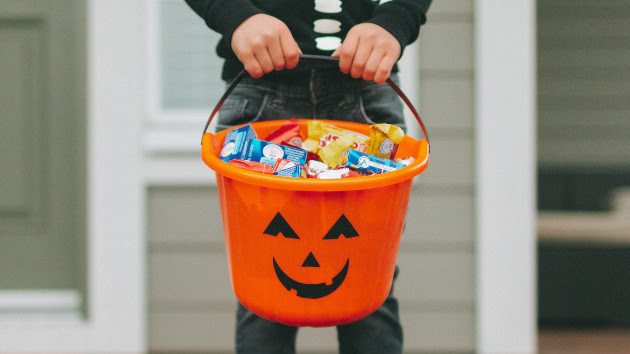(NEW YORK) — Halloween can come with a lot of fun, but also lots of concern for parents worried their kids are eating too much candy.
While some parents may respond to that stress by quickly getting all the candy out of their house or hiding it from their kids, one mom, Dani Lebovitz, a registered pediatric dietitian, says not so fast.
Lebovitz, a kids’ nutrition expert and founder of Kid Food Explorers, says the days and weeks after Halloween are a perfect time for kids to learn, play with and, yes, even eat, candy.
“If you are really struggling, take a deep breath,” Lebovitz told ABC News’ Good Morning America of her advice to parents and caregivers. “It’s a little extra sugar. It’s not going to influence or affect their lifelong health by having an abundance of candy today. In fact, it may even teach them some lifelong lessons.”
Contrary to the stereotype of candy being a sugar-filled treat that will make kids hyperactive and ruin their health, Lebovitz said she looks at candy as a “wonderfully fun, delicious learning opportunity.”
Here is how Lebovitz said she approaches Halloween candy with her own kids, ages 2, 4 and 6.
1. I often include candy alongside meals and snacks.
Lebovitz said she works to make sure her kids feel welcome to have candy when they want it, but she doesn’t give them “free access” to candy all day.
“I pretty much keep a bowl of the Halloween candy out on our counter for the first week or two [after Halloween] until my kids start to lose some interest in it and then I’ll put it in the pantry,” she said. “When we sit down for meals or snacks, I might put the [candy] bucket out or they may ask for it, and then I’m serving it, but I’m not just saying, ‘OK, it’s snack time. Here’s the candy bowl."”
Lebovitz said she’ll often include candy alongside her daughters’ meals and snacks, and if they want it in their school lunch, that’s OK too.
“When my 6-year-old is helping pack her lunch for school, she’ll throw several pieces [of candy] in,” Lebovitz said. “You can structure or limit the amount of candy they throw in, but I generally allow my child to choose. And that goes with any day of the week throughout the year.”
To help create structure, Lebovitz said she asks her daughter to eat food, candy included, in the kitchen only, not in other rooms of the house. And she encourages them to stay out of the pantry outside of meal and snack times.
“Just like any other snack, when we have meals and snack times, that’s when they can have [candy],” she said. “If they’re like, ‘Oh, I’m hungry,’ and it’s not what I’ve structured as a meal or snack time and they say they want a piece of candy, sometimes I say yes. Sometimes I say no, kind of gauging it on how … I think they’ve met their variety of foods for the day.”
Lebovitz said she also makes sure to serve a variety of foods to her kids, candy included, so they can learn “what tastes and feels best for them based on their taste and texture preferences.”
2. I encourage my kids to play with candy.
Lebovitz said a favorite activity among her daughters is to play food critic, and make a game out of critiquing and discussing the different types of candies they brought home from trick-or-treating.
Another activity her daughters enjoy, she said, is making patterns with the different candies, lining them up in different directions and shapes. She said her kids also like to create tasks, like figuring out how to make a car using pieces of candy.
Candies can also be a valuable learning tool for kids, according to Lebovitz, who said kids can sort the candy by shape, size and color, or use it to practice addition and subtraction, for example.
“Games and lessons that they feel like is just play for them but there is some really powerful learning,” Lebovitz said, adding that candy can also be a conversation starter for learning about different textures, ingredients and more.
A simple activity like placing candy in water and seeing what floats and what sinks can be a way to teach kids about density, Lebovitz recommends. In another example, she said kids can place gummy bear candies in regular and salt water to see which type of water makes the gummy bears expand, and why.
“Even the stressed out anxious parent around candy, if they can just take a breath and get creative and let their kids play or put out things that invite that play, it can be transformative for the entire family,” Lebovitz said.
3. I give my kids space to learn to trust their bodies.
With her own kids, Lebovitz said she wants to make sure they know that if there’s a candy they like, they’ll have access to it, and there’s no scarcity, which can contribute to binge and secretive eating tendencies.
She said she sees her own daughters stop eating candy when they’ve had enough and stop midway through a piece of candy if they don’t like it.
In addition, she said that she lets her kids learn on their own about how it may affect them if they eat too much candy at once and get a stomachache, for example.
“What I’m doing is I’m teaching them that their body can be trusted, that they don’t have to worry whether or not they’ll get to enjoy something that they love again,” she said. “Because they will have access to it again.”
Copyright © 2023, ABC Audio. All rights reserved.












